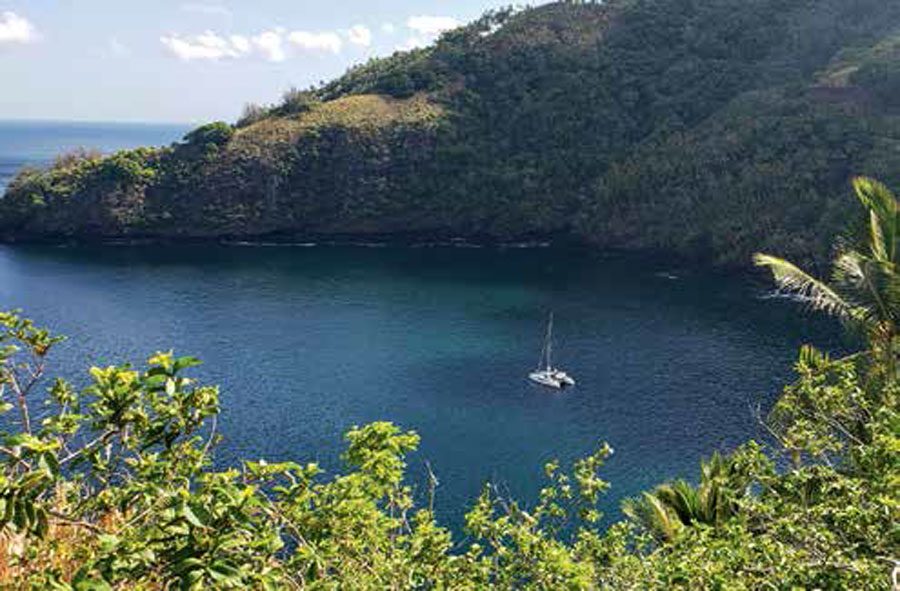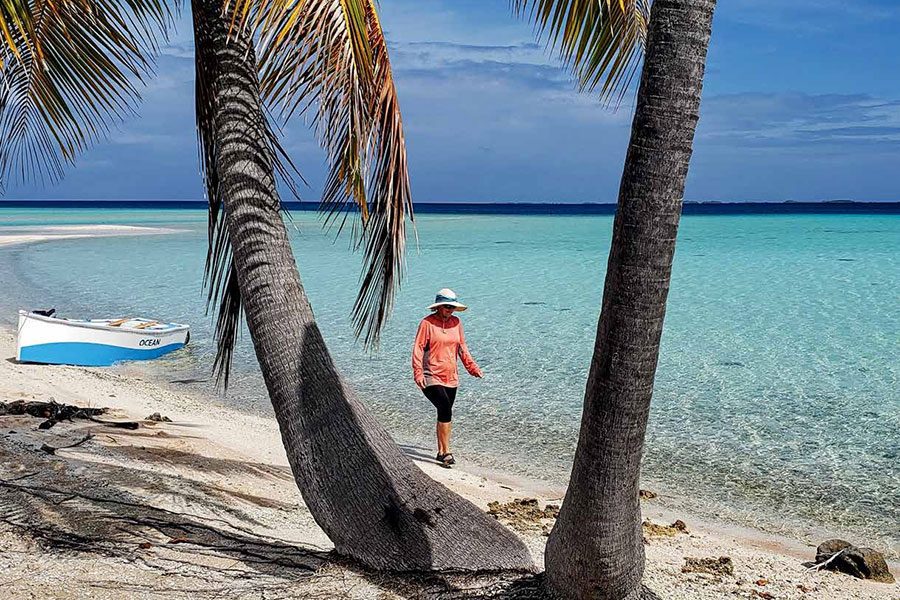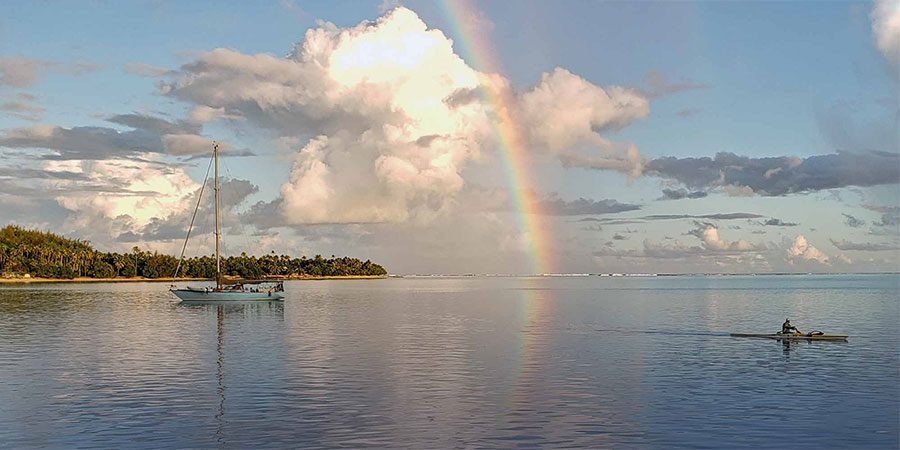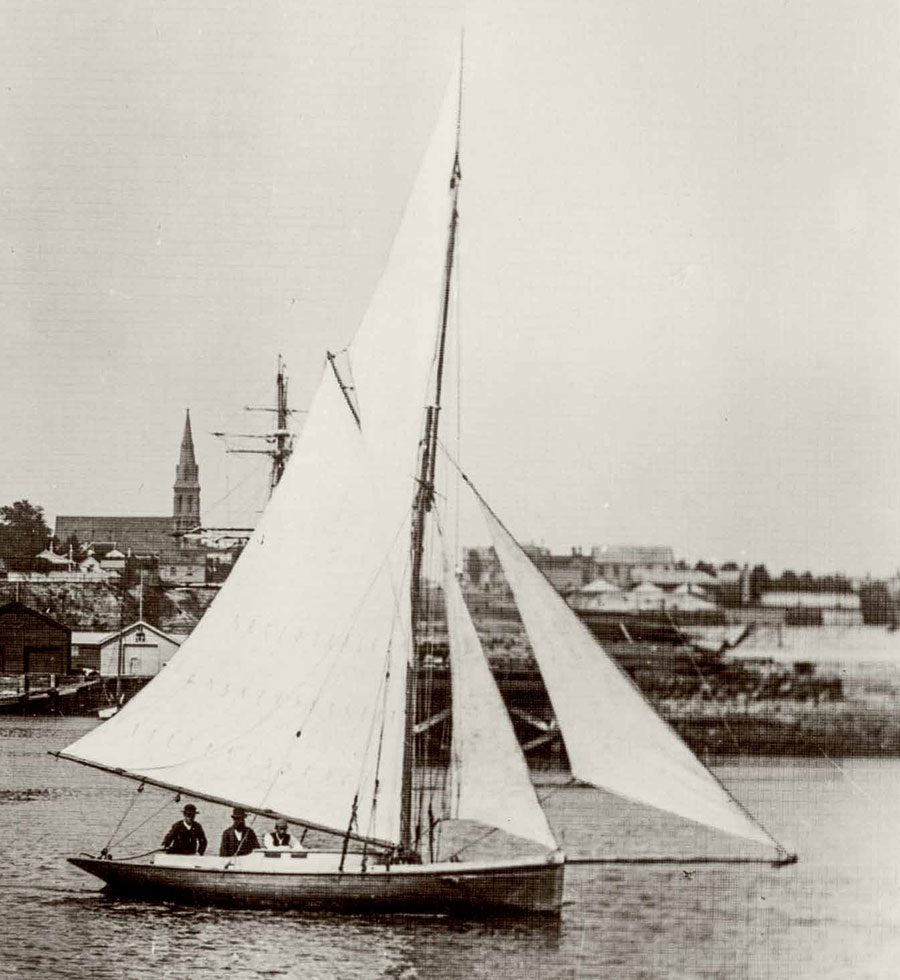

Tom and Harriet Linskey break their trans-Pacific journey at the isolated Marquesas Islands, halfway between Panama and New Zealand.
Really, really annoyed! Making a pit stop on our hike to a 1,000-foot waterfall in Daniel’s Bay, Hiva Oa, Harriet and I were enjoying lunch thanks to our new Marquesan friends, Teiki and his wife, Kua. Grilled fresh tuna, just-plucked fruit and veggies, yummy smoothies, their picnic bench café is lovely, a sunny wonder in the rainforest. It seemed like we’d happened upon the real Marquesas. But Teiki was really annoyed, and I didn’t understand why.
Teiki! Your trees are full of mango, papaya, breadfruit, bananas, oranges, lemons, avocados, pamplemousse. Your land is rich with taro, sweet potato, onion, peppers. The air you breathe is sweet with tiare blossoms. Your home has open-air walls and a tin roof, and a solar-powered, government subsidized freezer, refrigerator, TV, and stereo. Everything is picture-postcard Paradise. Teiki! Why are you so annoyed?


Tattoos, it turns out. Not Teiki’s tattoos – like almost every Marquesan, his body is adorned with inked-on touchstones that tell the story of his life, his beliefs, his hopes. Letting loose a mashup of island Marquesan-Tahitian-French, some of which I understood, Teiki is on his feet, marching with a wickedlooking spear he’d carved from hardwood – in a skirmish, you’d want this warrior on your side. Teiki doesn’t like the fact that, these days, tattoos are sold to everyone – German backpackers, tourists from the ships, sailors from the yachts – they’re inked onto anyone with a few Euros in their board shorts. In the old days a tattoo was a reward for building a home or fixing your neighbour’s boat, or a way to honour a newborn or an elder. But now that everybody was getting tattoos as tourist trinkets, tattoos meant nothing! Been there, got the T-shirt – and the tattoo. Fiu! Ue!
Teiki had a point. Marquesans have been watching their culture get chipped away, tipped over, chopped down, and hijacked for over 428 years, ever since a European sailing ship came over the horizon. The Marquesas, ten sunken volcanoes, high and craggy, with razor-sharp ridges and dusky valleys radiating to the sea, is a tiny, remote island group midway between Panama and New Zealand. Fate has placed the Marquesas squarely in the southeast trade winds, a logical landfall for cruising sailors from the west coast of Canada, the U.S., and South America. Sailing 3,000 to 4,000 miles, cruising sailors become the latest of outsiders bringing change to Polynesia.
The first European explorer to stumble upon the Marquesas, the Spaniard Alvaro de Mendana, arrived in 1595 after a long, lost voyage from the Straits of Magellan (they were searching for the Solomon Islands). As the misty green spires of Fatu Hiva rose ahead, the sailors fell to their knees, prayed, and cried. The Spaniards stayed in the Marquesas for two weeks, claiming the islands for the motherland, slaughtering 200 Marquesans, planting crosses, leaving syphilis in their wake, and setting a tone for colonial miscommunication and exploitation. Two hundred years passed without visitors, and then suddenly came American, British, and French vessels, trading with the ‘natives’ and planting the flag for God and country and king or queen.
Missionaries burned Marquesan tikis and kicked down their sacred places. Soon the once-strong Marquesan population was devastated by introduced diseases, alcohol, and firearms, which took 95% of the people. Around 1870 the islands were taken under the wing of the French, who today fund the infrastructure of modern life.
And now? The Marquesans are reclaiming their culture – as people rooted in legend and the land, their identity as warriors, as fearless oceanic voyagers and navigators – and they are honouring their past. They are shy and kind with cruising sailors, even as they are proud and a bit disdainful of their oceanic neighbours, the Tahitians, who they see as having sold their souls to tourism. Thankfully, the Marquesas will never be a major tourist destination. The sheer wildness of these islands rules that out: the sea is too rough, the mountains too steep, the location too remote. We cruising sailors know we must voyage thousands of miles just to reach them. And we won’t find white sand beaches, umbrella drinks, resorts with over-water bungalows, or jet-skis. Sometimes we won’t find a tenable anchorage or a safe place to land the dinghy. And we know that all of it, the Yin and Yang, will be wonderful.


Harriet and I had been here 34 years ago. In 1988 we sailed freelance, our 28-foot Bristol Channel Cutter, from Acapulco, Mexico, to Hiva Oa. Now we are anchored again in rolly Taiohae Bay, Nuku Hiva, on OCEAN, our 46-foot Dolphin 460 catamaran, with 50 other cruising boats. The Marquesas doesn’t seem to have changed much, but the cruising fleet has. Lots of boats – well, too many – in most of the anchorages. In our freelance days, when we’d cruised the Marquesas before GPS, there were places we didn’t dare go. These days, boats are bigger, more expensive, with fly-in, fly-out crew, and of course everyone has GPS. So, everyone goes everywhere. Sailing, and cruising, is less of a calling than just another experience to be checked off the list, like skydiving in Waialua or heli-skiing Bella Coola or booking a safari in Botswana. Fly in, fly out. It’s a different feeling. Weird to see the ethos playing out in the Marquesas.
Unlike the atolls of the Tuamotu Archipelago and the islands of French Polynesia, the Marquesas group lacks barrier reefs, and thus has no protection from ocean swells. Muscular seas from hundreds, even thousands of miles away sweep into Marquesan anchorages, even those you’d hope would be land-protected. The swells explode against cliffs and onto lava shelves, they rake stones over the shore, they thunder onto steep black sand beaches. You need to choose your anchorages prudently, stay alert to conditions, and be ready to clear out fast.
We hadn’t cruised all the Marquesas islands last time, so we resolved not to miss any this time, starting with a circumnavigation of Nuku Hiva. From Taiohae Bay we motored a few miles to Baie du Controleur, better known as Taipivai, the setting for Typee, Herman Melville’s iconic South Pacific tale. In Melville’s novel, the protagonist flees a whaling ship to live a daring life among the Marquesan ‘natives,’ a narrative that enthralled readers in 1844. But for us Taipivai was just as we’d remembered it: the Garden of Eden in a Marquesan valley. Flowers blossomed, the scent of vanilla wafted, life went on as tranquilly as ever. The astonishing part was nothing had changed.
Our circumnavigation brought one vista after another into view: a topography of steeples, witches’ hats, eroded pinnacles, domes, breath-taking cliffs. Amazing sights but only a couple of places we’d consider anchoring – and those only if the swell died or the wind shifted. This, too, was the Marquesas we remembered: beautiful but unforgiving.

We sailed by more than four dozen valleys, green, deep, dusky, deserted. Marquesans of hundreds and thousands of years ago lived in these valleys, each group separated from the next by steep ridges. Hike any valley and you’ll find tikis, carvings, petroglyphs, the stone platforms of dwellings. At the top of the valley the altars of priests command a view of sun and stars and a sweep of sea to the horizon. The valleys are eerily still. Not a sound. You walk slowly among tumbled, ancient remains. People, animals, agriculture, all gone. Sadness remains.
Leaving Nuku Hiva, we sailed 35 miles west to the sawtooth silhouette of Ua Huka, hopeful, but both anchorages we tried proved untenable. Havei, a niche recommended by a cruiser, was out of the question, even in moderate trade winds and seas. Around the corner, we investigated narrow, south-facing Vaipaee, which has a low wharf for an occasional supply ship. As soon as we pulled back on our anchor, we knew we couldn’t stay – the harbour, a cul-de-sac into which waves funnelled, could get dangerous with just a slight increase in swell.
We hauled up the anchor and sailed away just before sunset, jogging 60 miles to Hiva Oa, a high, bountiful island whose fragrant greeting – blossoming flowers from the mountains – met us 12 miles away. We hove-to in the lee of the neighbour isle of Tahuata, and in the morning we anchored in Hanamoenoa, a quiet bay with flat water and good holding.
Feeling a bit ragged, we stayed a few peaceful days in Tahuata, dazzled by manta rays swooping across the anchorage. We even went snorkelling, a rarity. In nearly every anchorage in the Marquesas, the water clarity is ten feet and often less, and the sea growth on your boat’s bottom is staggering. In days your clean bottom is covered in pimply barnacles, and thick, tenacious grass and baked-on slime take root along the boot top. In the Marquesas you are afloat not in in sea water but in a soup – a thick green soup – of sea creatures.


For three decades the island of Fatu Hiva had been high on our list – and it was also on the shortlist of every other cruiser. We sailed to windward most of the day and arrived to find 16 boats crowded into an anchorage that holds half a dozen, which meant that we and others anchored way, way out, in 100-plus feet of choppy, roiling water, with ocean erupting onto nearby cliffs. Ashore the village was all peace and smiles, framed by a brilliant green volcanic plugs and steep, rippled ridges. We came upon the house and workshop of Sopi, a renowned Fatu Hiva artiste, and we bought a pint-sized round-tummied tiki for our someday mantelpiece. A spate of intensified trade winds that evening brought williwaws and violent sailing at anchor, turning the situation a bit frightening. This – the Marquesas yin and yang, usually both in a day, sometimes both at once – we remembered. And it was why, last time, we hadn’t visited all the islands. There’s only so much adventure you can take.
Broad-reaching away from Fatu Hiva, we found a reasonably safe but crowded anchorage, Atuona on Hiva Oa, and decided to go exploring for a day. Normally, tourist tours are a turn-off for me, but we knew we’d got lucky with our guide, Maeva. As he drove the four-wheeler he told us that his extended family is spread far and wide across Polynesia. Later we discovered that, when in Tahiti with his Tahitian cousins, he surfs Teahupo’o, one of the world’s most terrifying reef-break waves. Teiki is the past, made present. He’s bringing the lore of the islands into the future. Maeva is the real thing: a Marquesan.
Maeva reveres the ancestors. Leading us deep into shaded valleys to the ancient altars and ceremonial grounds, he helped us see the where chiefs spoke, where children played and warriors rested, where women weaved and men carved tikis and weapons. The valleys are dark and spooky with the past. Gods and tikis, thousand-year-old roads of lava stones and coral, pits for storing breadfruit, pits for battle captives, platforms for human sacrifice. When we moved away from these sacred places back to the car, Maeva turned and bid a low, rasping farewell to the spirits, the tupapau.
A couple of days later, we sailed back to Tahuata and ran into Captain James Cook. Well, his spirit, anyway. Off the village of Vaitehu we dropped our 40kg Rocna in 12m of water just as a williwaw threw OCEAN sideways. Followed by another williwaw. And another. And another – the chute-shaped valley was manufacturing them every few minutes. Our anchor held, but surf was erupting on rocks just to leeward. Compounding the williwaws, newly-built sea defences – in this and many Marquesan harbours the French have built breakwaters and bulldozed boulders and jacks onto beaches, all to stop the hungry sea from munching away at villages – have filled anchorages with ricocheting backwash. We were being blown and bounced out of Vaitehu.
In his three voyages of discovery in Endeavour and Resolution from 1768 to 1780, Captain Cook had sailed nearly everywhere and charted nearly everything in the Pacific. When he first found the Marquesas in 1774, ranging along the leeward side of Tahuata, Cook wrote: “At length we came to the Port we were in search after, into which we hauled and made an attempt to turn in, the doing of which we were attacked by such Violent Squalls from the high lands that we were within a few yards of being driven against the rocks to Leeward. After escaping this danger, we stood out again and made a stretch to windward and then stretched in and Anchored in the Entrance of the Bay in 34 fathom water. . .”

Yep. Cook, too, got blown out of Vaitehu. (Nice to know that 250 years later, the williwaws are still doing their thing.) But unlike Cook, after we pulled up our anchor, we motored back up the coast and anchored in Hanamoenoa. A bay with many manta rays but not one williwaw.
With its skyline of epic pinnacles, trade wind clouds caught on the tips like shreds of cotton candy, the island of Ua Pou was calling. But the harbour of Hakahau, the only spot sheltered by a breakwater, was chock-full of bow-and-stern-anchored boats. There was no place for us. We continued sailing counterclockwise around the island, keeping a safe distance between the rocks and cliffs, the swell crashing and surging. Other spots we tried seemed workable from half a mile out, but once in the anchorage things got iffy. In Hakamaii it seemed the entire village, flowered muumuus and straw hats, was having Sunday service in a palm-roofed seaside church, oblivious to a catamaran coming into the harbour and hurrying back out.
We were quickly nearing the end of Ua Pou and running out of options. We ventured very, very carefully into Hikeu, a deeply indented cove inside a Zone Non Hydrographiee (unsurveyed) and anchored in 11m, the water constantly moving but not dangerous. Landing our dinghy on the surfy, stony beach was impossible, but we’d gotten used to that. We were in the Marquesas, that’s all. So beautiful. So rugged. So, we’ll stay on the boat.
And so Ua Pou was our last island of the Marquesas. We prepared OCEAN for an ocean passage to the atolls of the Tuamotu Archipelago, 420 miles south in the easterly trade winds. Already we hungered for the peace of flat water behind a barrier reef, and we longed to stroll perfect white sand beaches. And already we missed the Marquesas, in all of its Yin and Yang. We’d returned to the Marquesas and, same as 34 years before, there was a lot that we didn’t see, couldn’t see. But we found that, remote and alone and proud, the Marquesas Island group, rough-cut emeralds set in a wide Pacific, is still unique. And we believe it always will be. BNZ





